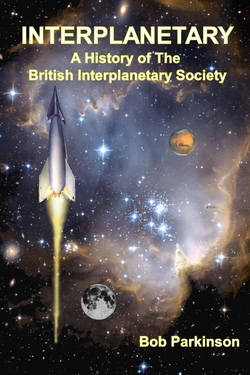Centauri Dreams
Imagining and Planning Interstellar Exploration
Parsing Exoplanet Weather
Although it seems so long ago as to have been in another century (which it actually almost was), the first detection of an exoplanet atmosphere came in the discovery of sodium during a transit of the hot Jupiter HD 209458b in 2002. To achieve it, researchers led by David Charbonneau used the method called transmission spectroscopy, in which they analyzed light from the star as it passed through the atmosphere of the planet. Since then, numerous other compounds have been found in planetary atmospheres, including water, methane and carbon dioxide.
Scientists also expect to find the absorption signatures of metallic compounds in hot Jupiters, and these have been detected in brown dwarfs as well as ultra-hot Jupiters. Now we have new work out of SRON Netherlands Institute for Space Research and the University of Groningen. Led by Marrick Braam, a team of astronomers has found evidence for chromium hydride (CrH) in the atmosphere of the planet WASP-31b, a hot Jupiter with a temperature of about 1200° C in the twilight region where light from the star passes through the atmosphere during a transit.
This is an interesting find because it has implications for weather. The temperature in this region is just where chromium hydride transitions from a liquid to a gas at the corresponding pressure in the atmosphere, making it a potential weather-maker just as water is for Earth. Braam speaks of the possibility of clouds and rain coming out of this, but hastens to add that while his team found chromium hydride with Hubble and Spitzer data, it found none in data from the Very Large Telescope (VLT). That would place the find in the realm of ‘evidence’ rather than proof.
Even so, it gives us something interesting to work with, assuming we do get the James Webb Space Telescope into space later this year. Co-author and SRON Exoplanets program leader Michiel Min notes the significance of the orbital lock hot Jupiters fall into:
“Hot Jupiters, including WASP-31b, always have the same side facing their host star. We therefore expect a day side with chromium hydride in gaseous form and a night side with liquid chromium hydride. According to theoretical models, the large temperature difference creates strong winds. We want to confirm that with observations.”
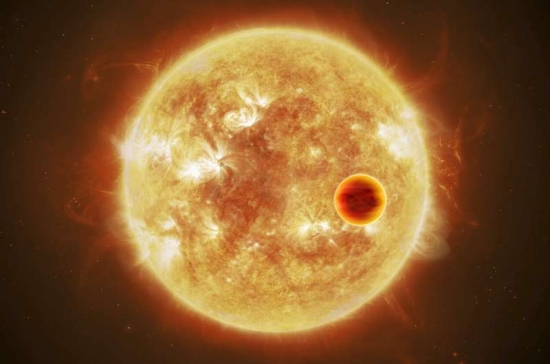
Image: A hot Jupiter crossing the face of its star as seen from Earth. Credit: ESA/ATG medialab, CC BY-SA 3.0 IGO.
WASP-31b orbits an F star at a distance of 0.047 AU and is one of the lowest density exoplanets yet found, with a mass of 0.478 that of Jupiter and a radius 1.549 times Jupiter’s. Potassium has already been found in its atmosphere as well as evidence for aerosols in the form of clouds and hazes, with some evidence for water vapor and ammonia. Braam and team analyzed previously available transmission data from Hubble and Spitzer using a software retrieval code called TauRex (Tau Retrieval for Exoplanets), reporting “the first statistical evidence for the signatures of CrH in an exoplanet atmosphere.” The paper goes on to note:
The evidence for CrH naturally follows from its presence in brown dwarfs and is expected to be limited to planets with temperatures between 1300 and 2000 K. Cr-bearing species may play a role in the formation of clouds in exoplanet atmospheres, and their detection is also an indication of the accretion of solids during the formation of a planet.
The paper is Braam et al., “Evidence for chromium hydride in the atmosphere of hot Jupiter WASP-31b,” accepted at Astronomy & Astrophysics. Abstract / Full Text.

Magnetic Reconnection in New Thruster Concept
At the Princeton Plasma Physics Laboratory (PPPL) in Plainsboro, New Jersey, physicist Fatima Ebrahimi has been exploring a plasma thruster that, on paper at least, appears to offer significant advantages over the kind of ion thruster engines now widely used in space missions. As opposed to electric propulsion methods, which draw a current of ions from a plasma source and accelerate it using high voltage grids, a plasma thruster generates currents and potentials within the plasma itself, thus harnessing magnetic fields to accelerate the plasma ions.
What Ebrahimi has in mind is to use magnetic reconnection, a process observed on the surface of the Sun (and also occurring in fusion tokamaks), to accelerate the particles to high speeds. The physicist found inspiration for the idea in PPPL’s ongoing work in fusion. Says Ebrahimi:
“I’ve been cooking this concept for a while. I had the idea in 2017 while sitting on a deck and thinking about the similarities between a car’s exhaust and the high-velocity exhaust particles created by PPPL’s National Spherical Torus Experiment (NSTX). During its operation, this tokamak produces magnetic bubbles called plasmoids that move at around 20 kilometers per second, which seemed to me a lot like thrust.”
In magnetic reconnection, magnetic field lines converge, separate, and join together again, producing energy that Ebrahimi believes can be applied to a thruster. Whereas ion thrusters propelling plasma particles via electric fields can produce a useful but low specific impulse, the magnetic reconnection thruster concept can, in theory, generate exhausts with velocities of hundreds of kilometers per second, roughly ten times the capability of conventional thrusters.
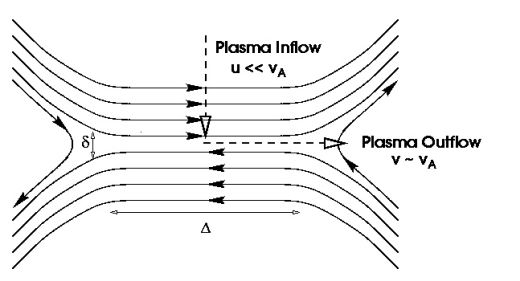
Image: Magnetic reconnection refers to the breaking and reconnecting of oppositely directed magnetic field lines in a plasma. In the process, magnetic field energy is converted to plasma kinetic and thermal energy. Credit: Magnetic Reconnection Experiment.
Writing up the concept in the Journal of Plasma Physics, Ebrahimi notes that this thruster design allows thrust to be regulated through changing the strength of the magnetic fields. The physicist describes it as turning a knob to fine-tune the velocity by the application of more electromagnets and magnetic fields. In addition, the new thruster ejects both plasma particles and plasmoids, the latter a component of power no other thruster can use.
If we could build a magnetic reconnection thruster like this, it would allow flexibility in the plasma chosen for a specific mission, with the more conventional xenon used in ion thrusters giving way to a range of lighter gases. Ebrahimi’s 2017 work showed how magnetic reconnection could be triggered by the motion of particles and magnetic fields within a plasma, with the accompanying production of plasmoids. Her ongoing fusion research investigates the use of reconnection to both create and confine the plasma that fuels the reaction without the need for a large central magnet.
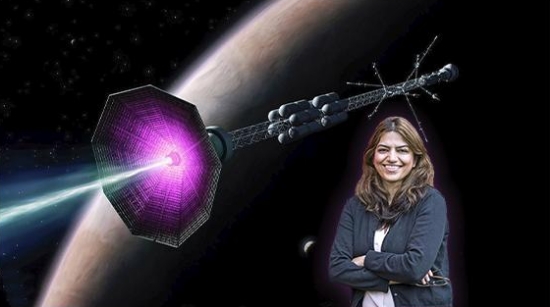
Image: PPPL physicist Fatima Ebrahimi in front of an artist’s conception of a fusion rocket. Credit: Elle Starkman, PPPL Office of Communications, and ITER.
Thus research into plasmoids and magnetic reconnection filters down from the investigation of fusion into an as yet untested concept for propulsion. It’s important to emphasize that we are, to say the least, in the early stages of exploring the new propulsion concept. “This work was inspired by past fusion work and this is the first time that plasmoids and reconnection have been proposed for space propulsion,” adds Ebrahimi. “The next step is building a prototype.”
The paper is Ebrahimi, “An Alfvenic reconnecting plasmoid thruster,” Journal of Plasma Physics Vol. 86, Issue 6 (21 December 2020). Abstract.

The Xallarap Effect: Extending Gravitational Microlensing
‘Xallarap’ is parallax spelled backward (at least it’s not another acronym). And while I doubt the word will catch on in common parlance, the effect it stands for is going to be useful indeed for astronomers using the Nancy Grace Roman Space Telescope. This is WFIRST — the Wide Field Infrared Survey Telescope — under its new name, a fact I mention because I think this is the first time we’ve talked about the mission since the name change in 2020.
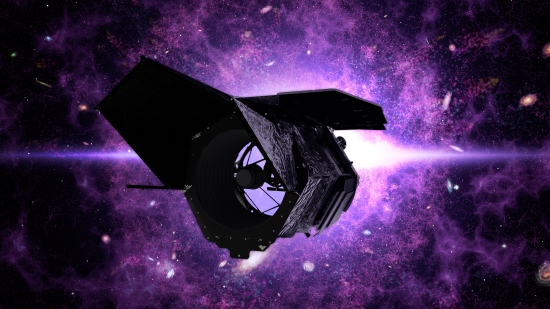
Image: High-resolution illustration of the Roman spacecraft against a starry background. Credit: NASA’s Goddard Space Flight Center.
While a large part of its primary mission will be devoted to dark energy and the growth of structure in the cosmos, a significant part of the effort will be directed toward gravitational microlensing, which should uncover thousands of exoplanets. This is where the xallarap effect comes in. It’s a way of drawing new data out of a microlensed event, so that while we can continue to observe planets around a nearer star as it aligns with a background star, we will also be able to find large planets and brown dwarfs orbiting the more distant stars themselves.
Let’s back up slightly. The gravitational microlensing we’ve become familiar with relies on a star crossing in front of a more distant one, a chance alignment that causes light from the farther object to bend, a result of the curvature of spacetime deduced by Einstein. The closer star acts as a lens, making light from the background star appear magnified, and the analysis of that magnified light can also show the signature of a planet orbiting the lensing star. It’s a method sensitive to planets as small as Mars.
Moreover, gravitational microlensing makes it possible to see planets in a wide range of orbits. While the alignment events are one-off affairs — the stars from our vantage point are not going to be doing this again — we do have the benefit of being able to detect analogs of most of the planets in our own system. What Shota Miyazaki (Osaka University) and colleagues have demonstrated in a new paper is that ‘hot Jupiters’ and brown dwarfs will also be detectable around the more distant star. Xallarap is their coinage.
David Bennett leads the gravitational microlensing group at NASA GSFC:
“It’s called the xallarap effect, which is parallax spelled backward. Parallax relies on motion of the observer – Earth moving around the Sun – to produce a change in the alignment between the distant source star, the closer lens star and the observer. Xallarap works the opposite way, modifying the alignment due to the motion of the source.”
Image: This animation demonstrates the xallarap effect. As a planet moves around its host star, it exerts a tiny gravitational tug that shifts the star’s position a bit. This can pull the distant star closer and farther from a perfect alignment. Since the nearer star acts as a natural lens, it’s like the distant star’s light will be pulled slightly in and out of focus by the orbiting planet. By picking out little shudders in the starlight, astronomers will be able to infer the presence of planets. Credit: NASA’s Goddard Space Flight Center.
The Roman telescope will be digging into the Milky Way’s central bulge in search of such objects as well as the thousands of exoplanets expected to be found through the older microlensing method, which Xallarap complements. And while microlensing works best at locating planets farther from their star than the orbit of Venus, xallarap appears to be better suited for massive worlds in tight orbits, which produce the biggest tug on the host star.
This will include the kind of ‘hot Jupiters’ we’ve found before but still have problems explaining in terms of their formation and possible migration, so finding them through the new method should add usefully to the dataset. In a similar way, the Roman instrument’s data on brown dwarfs found through xallarap should extend our knowledge of multiple star systems that include these objects, which are more massive than Jupiter but roughly the same radius.
Given that the view toward galactic center takes in stars that formed as much as 10 billion years ago, the Roman telescope will be extending the exoplanet search significantly. Until now, we’ve homed in on stars no more than a few thousand lights years out, the exception being those previously found through microlensing. The xallarap effect will complement the mission by helping us find older planets and brown dwarfs that fill in our knowledge of how such systems evolve. How long can a hot Jupiter maintain its tight orbit? How frequently will we find objects like these around ancient stars?
We should start getting useful data from both xallarap and more conventional microlensing some time in the mid-2020s, when the Roman instrument is due to launch. Nice work by Miyazaki and team.
The paper is Miyazaki et al., “Revealing Short-period Exoplanets and Brown Dwarfs in the Galactic Bulge Using the Microlensing Xallarap Effect with the Nancy Grace Roman Space Telescope,” Astronomical Journal Vol. 161, No 2 (25 January 2021). Abstract.

How Common Are Giant Planets around Red Dwarfs?
A planet like GJ 3512 b is hard to explain. Here we have a gas giant that seems to be the result of gravitational instabilities inside the ring of gas and dust that circles its star. This Jupiter-like world is unusual because of the ratio between planet and star. The Sun, for example, is about 1050 times more massive than Jupiter. But for GJ 3512 b, that ratio is 270, a reflection of the fact that this gas giant orbits a red dwarf with about 12 percent of the Sun’s mass. How does a red dwarf produce a debris disk that allows such a massive planet to grow?
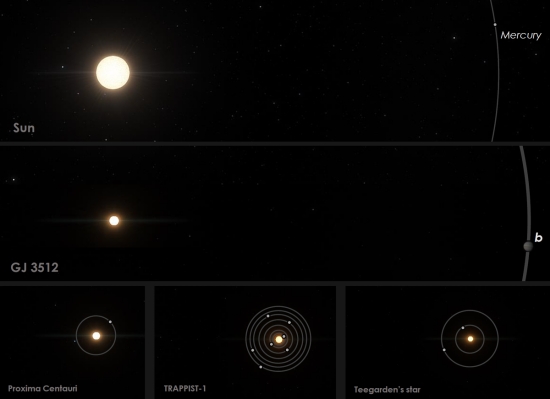
Image: Comparison of GJ 3512 to the Solar System and other nearby red-dwarf planetary systems. Planets around solar-mass stars can grow until they start accreting gas and become giant planets such as Jupiter, in a few millions of years. However, up to now astronomers suspected that, except for some rare exceptions, small stars such as Proxima, TRAPPIST-1, Teegarden’s star, and GJ 3512 were not able to form Jupiter mass planets. Credit: © Guillem Anglada-Escude – IEEC/Science Wave, using SpaceEngine.org (Creative Commons Attribution 4.0 International; CC BY 4.0).
I bring up GJ 3512 b (discovered in 2019) as an example of the kind of anomaly that highlights the gaps in our knowledge. While we often talk about red dwarf systems in these pages, the processes of planet formation around these stars remain murky. M-dwarfs may make up 80 percent of the stars in the Milky Way, but they host a scant 10 percent of the exoplanets we’ve found thus far. To tackle this gap, a team of scientists led by Nicolas Kurtovic (Max Planck Institute for Astronomy, Heidelberg) has released the results of its analysis of six very low mass stars n the Taurus star-forming region. These are stars with mass less than 20% that of the Sun.
The new work relies on data from the Atacama Large Millimeter/submillimeter Array (ALMA), taken at a wavelength of 0.87 millimeters in order to trace dust and gas in the disk around these stars at an angular resolution of 0.1 arcseconds. What’s intriguing here are the signs of ring-like structures in the dust that extend between 50 and 90 AU from the stars, which reminds us of similar, much larger disks around more massive stars. Half of the disks the Kurtovic team studied showed structures at these distances. The consensus is that such rings are markers for planets in the process of formation as they accumulate gas and dust.
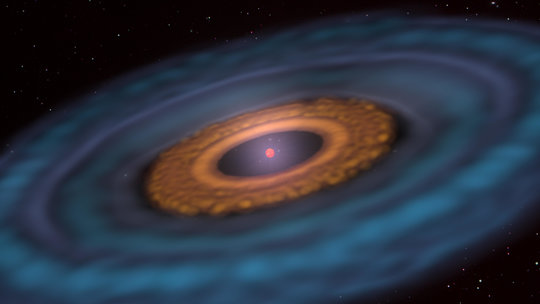
Image: Artistic representation of a planet-forming disk of dust and gas around a very low-mass star (VLMS). The inner dust disk contains a ring structure that indicates the formation of a new planet. The dust disk resides inside a larger gas disk whose thickness increases towards the edge. Credit: MPIA graphics department.
In the case of the M-dwarfs under study, the gaps in the rings being cleared by these planets would require worlds about as massive as Saturn, an indication that the material for gas giant formation is available. But time is a problem: Inward-movng dust evaporates close to the star, and in the case of red dwarfs, the migration is twice as fast as for more massive stars. There is little time in such a scenario for the planetary embryos needed for core accretion to form.
This is, I think, the key point in the paper, which notes the problem and explains current thinking:
The core accretion scenario for planet formation assumes collisional growth from sub-µm-sized dust particles from the interstellar medium (ISM) to kilometer-sized bodies or planetesimals… The collisions of particles and their dynamics within the disk are regulated by the interaction with the surrounding gas. Different physical processes lead to collisions of particles and their potential growth, such as Brownian motion, turbulence, dust settling, and radial drift…
Much depends upon the star in question. The paper continues (italics mine):
All of these processes have a direct or indirect dependency on the properties of the hosting star, such as the temperature and mass. For instance, from theoretical calculations, settling and radial drift are expected to be more efficient in disks around VLMS [Very Low Mass Stars] and BDs [Brown Dwarfs], with BD disks being 15-20% flatter and with radial drift velocities being twice as high or even more in these disks compared to T-Tauri disks.
The authors estimate that the ringed structures they’ve found around three of the red dwarfs under study formed approximately 200,000 years before the dust would have migrated to the central star. So planet formation must be swift: The planetary embryos need to accumulate enough mass to create gaps in the disk, which effectively block the dust from further inward migration. Without these gaps, the likelihood of planet formation drops.

Image: Observational data and model of the dust disk around the VLMS MHO6. Left: Image of the dust disk. Middle: The disk model with a 20 au wide central hole, which is consistent with a Saturn-mass planet located at a distance of 7 au from the star, accreting disk material. Right: Radial profile of the model (blue) and after convolving it with the telescope’s angular resolution (red). The black symbols represent the data obtained from the measured brightness distribution. The grey bar corresponds to the angular resolution of the observations. Credit: Kurtovic et al./MPIA.
Remember, we only have six stars to work with here, and the other three stars under investigation are likewise problematic. They appear to show dust concentrations between 20 and 40 AU from their stars, but in all three cases lack structure that can be defined by ALMA. Better resolution would, the authors believe, tease out rings inside even these smaller disks.
But the paper acknowledges that disks around stars that are still lower in mass demand that inward migration be reduced through ‘gas pressure bumps’ that can trap dust efficiently. Here’s the process (once again, the italics are mine):
The presence of pressure bumps produces substructures, such as rings, gaps, spiral arms, and lopsided asymmetries, with a different amplitude, contrasts, and locations depending on the origin of the pressure variations… Currently, due to sensitivity limitations, most of our observational knowledge about substructures comes from bright (and probably massive) disks, such as the DSHARP sample… A less biased sample of ALMA observations of disks in the star-formation region of Taurus has demonstrated that at least 33% of disks host substructures at a resolution of 0.1”, and the disks that do not have any substructures are compact (dust disk radii lower that ?50 au…). It remains an open question if compact disks are small because they lack pressure bumps or because current observations lack the resolution to detect rings and gaps in these disks.
Such pressure bumps are a workable explanation but one without the kind of observational evidence we’ll need as we continue to investigate planet formation around low-mass stars and brown dwarfs. We are a long way from having a fully developed model for planet formation in this environment, and the Kurtovic et al. paper drives the point home. On a matter as fundamental as how common planets around red dwarfs are, we are still in the early stages of data gathering.
The paper is Kurtovic, Pinilla, et al., “Structures of Disks around Very Low Mass Stars in the Taurus Star-Forming Region,” Astronomy & Astrophysics, 645, A139 (2021). Abstract / Preprint.

TYC 7037-89-1: A Six Star System with Three Eclipsing Binaries
This seems to be the week of unusual configurations. Following up on TRAPPIST-1 and TOI-178 comes TYC 7037-89-1, where we have fully six stars in a single system, all of which participate in eclipses. In other words, what TESS has revealed is a system consisting of three eclipsing binaries. It’s located about 1,900 light years out in Eridanus, and if it doesn’t remind you of Isaac Asimov’s “Nightfall,” nothing will. In the story (published in the September 1941 issue of Astounding Science Fiction), the planet Lagash is illuminated almost constantly by one of the six stars in its system. The discovery of what happens when it is not — which occurs every 2,000 years or so — drives the plot of one of Asimov’s best tales.
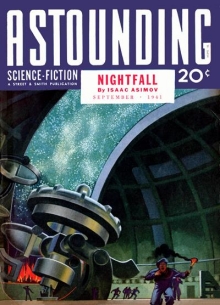
TYC 7037-89-1 (also known as TIC 168789840), marks the first time a six-star system has been found where all the stars are involved in eclipses as seen from our vantage point. This leads to complicated orbital dynamics. With the three binaries designated A, B and C, we learn that the two stars making up A and C respectively orbit each other every day and a half, as measured by the dip in system brightness when one star passes in front of another. The A and C binaries, in turn, orbit each other on a timeframe of about four years.
But we’re not through. The binary B also has two members, which orbit each other every eight days. This pair is considerably further away, so that it orbits the two inner binaries every 2,000 years or so (there goes Asimov again). All three binaries have primary stars a bit larger and more massive than the Sun, with the secondary stars in all three cases being about half the Sun’s size, and no more than a third as hot. The remarkable point is that to detect all three binaries, we have to have orbital planes aligned with our observations from TESS, and this is occurring despite their wide separation. Have a look at all this in the diagram below.
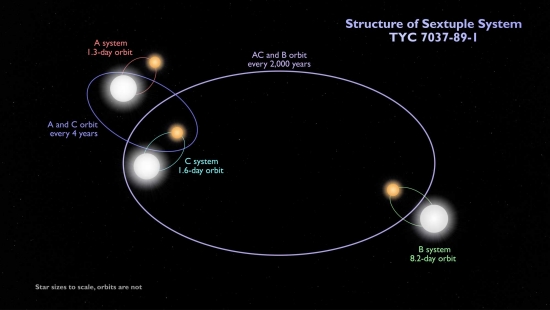
Image: This schematic shows the configuration of the sextuple star system TYC 7037-89-1. The inner quadruple is composed of two binaries, A and C, which orbit each other every four years or so. An outer binary, B, orbits the quadruple roughly every 2,000 years. All three pairs are eclipsing binaries. The orbits shown are not to scale. Credit: NASA’s Goddard Space Flight Center.
Veselin Kostov (SETI Institute) and Brian Powell (NASA GSFC) led the team behind this discovery. Says Kostov:
“Multiply-eclipsing multiple systems such as TYC 7037-89-1 enable simultaneous, precise measurements on the stellar sizes, temperatures, and potentially masses, of pairs of stars that share common history. In turn, this provides better understanding of stellar formation and evolution in dynamically-rich environments.”
The international team included Saul Rappaport (MIT), Tamás Borkovits (University of Szeged, Hungary), Petr Zasche (Charles University, Czech Republic, and Andrei Tokovinin (NSF NOIRLab). A great deal of data mining went into their study, which included using the NASA Center for Climate Simulation’s Discover supercomputer at GSFC to examine brightness variations in 80 million stars in the TESS dataset. Their neural network found 450,000 eclipsing binary candidates, about 100 of which included three or more stars, as well as this system.
TYC 7037-89-1 naturally raises questions about how such a system formed and provides a useful laboratory for the study of orbital interactions in such complex scenarios. And while it’s not the first six-star system we’ve found, it’s the first to show three eclipsing binaries. From the paper:
TIC 168789840 is a fascinating system that naturally merits additional observation and analysis. Though quite similar to the famous Castor system, the “triplet” nature of TIC 168789840 combined with the presence of three primary and three secondary eclipses enable further investigations into its stellar formation and evolution. Remarkable objects like TIC 168789840 or Castor give us insights on the formation of multiple systems — a matter of active research and debate. It is well known that components of hierarchical systems have correlated masses (Tokovinin 2018a), suggesting accretion from a common source. On the other hand, disk fragmentation and subsequent migration, driven by accretion, appears to be the dominant mechanism of close binary formation…
One possible model discussed in the paper: A binary star captures a third star, with subsequent fragmentation of each of the stars:
With regard to TIC 168789840, we might think that an encounter of the young binary AC with another star B led to its capture on a wide orbit, while strong accretion from the unified envelope, caused by this dynamical event, formed seed secondary companions to all stars by disk fragmentation. The seeds continued to grow and migrate inward, while the intermediate and outer orbits also evolved.
That, of course, is one among a cluster of possibilities to be investigated as more candidate multi-star systems are analyzed. The paper points out that another sextuple system is to be analyzed in a forthcoming paper, which will make a useful point of comparison. Meanwhile, we’re reminded again of the power of artificial intelligence at producing discoveries in voluminous datasets. AI is increasingly the pointer for follow-up studies that pay off.
The paper is Powell et al., “TIC 168789840: A Sextuply-Eclipsing Sextuple Star System,” accepted at The Astronomical Journal (preprint).

TOI-178: Six Transiting Planets & a Unique Resonance Chain
Yesterday’s story on the seven planets around TRAPPIST-1 dovetails nicely with the just announced find from scientists at CHEOPS. The ESA space telescope has determined that there are six planets around the star TOI-178. About 200 light years from Earth, this is a high proper-motion K-dwarf, the outer five of whose planets are locked into a 2:4:6:9:12 chain of Laplace resonances. The innermost world does not participate in the resonance.
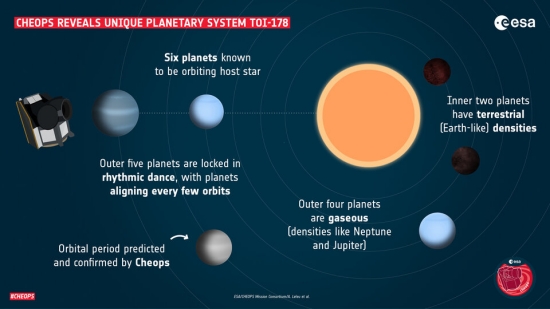
Image: Infographic of the TOI-178 planetary system. Credit: ESA.
But more to the point of the TRAPPIST-1 comparison, whereas the seven planets there show similar densities, implying like compositions, the six worlds around TOI-178 show, in complete contrast to the orderly harmonics of their orbits, a wide range in density. The two inner planets have densities compatible with rocky worlds, while the outer four are gaseous. This is unusual for systems in this kind of complex resonance. No wonder ESA project scientist Kate Isaak is drawn up short:
“It is the first time we observe something like this. [In] the few systems we know with such a harmony, the density of planets steadily decreases as we move away from the star. In the TOI-178 system, a dense, terrestrial planet like Earth appears to be right next to a very fluffy planet with half the density of Neptune followed by one very similar to Neptune.”
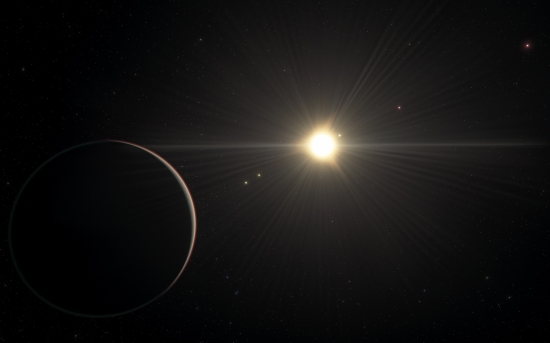
Image: This artist’s impression shows the view from the planet in the TOI-178 system found orbiting furthest from the star. New research by Adrien Leleu and his colleagues with several telescopes, including ESO’s Very Large Telescope, has revealed that the system boasts six exoplanets and that all but the one closest to the star are locked in a rare rhythm as they move in their orbits. But while the orbital motion in this system is in harmony, the physical properties of the planets are more disorderly, with significant variations in density from planet to planet. This contrast challenges astronomers’ understanding of how planets form and evolve. This artist’s impression is based on the known physical parameters for the planets and the star seen. Credit: ESO/L. Calçada/spaceengine.org.
To produce the study, the CHEOPS measurements were enhanced by the addition of data from the TESS mission as well as the ESO spectrograph ESPRESSO, allowing scientists to measure the orbits and sizes of the planets: The orbital periods are 1.91, 3.24, 6.56, 9.96, 15.23, and 20.71 days respectively, while size ranges from 1.1 to 3 times Earth’s radius. It’s interesting to see that the 6th world around TOI-178 was found by extrapolating from the resonance pattern to look for a planet in a 15-day orbit to match the chain. After a short shutdown of CHEOPS observations, additional data were collected, confirming the existence of the 6th world. From the paper:
Careful analysis of the whole system additionally revealed that planets c, d, e, and g were in a Laplace resonance. In order to fit in the resonant chain, the unknown period of the additional planet could have only two values: P = 13.4527 d or P = 15.2318 d…, the latter value being more consistent with the RV data. A fourth CHEOPS visit was therefore scheduled for 3 October, and it detected the transit for the additional planet at a period of 15.231915 day[s]…
Lead author Adrien Leleu (University of Bern, University of Geneva and the National Center of Competence in Research PlanetS) puts the matter this way:
“This result surprised us, as previous observations with the Transiting Exoplanet Survey Satellite (TESS) of NASA pointed toward a three planets system, with two planets orbiting very close together. We therefore observed the system with additional instruments, such as the ground based ESPRESSO spectrograph at the European Southern Observatory (ESO)’s Paranal Observatory in Chile, but the results were inconclusive… After analyzing the data from eleven days of observing the system with CHEOPS, it seemed that there were more planets than we had initially thought.”
The animation below puts the system into motion.
Image: Artist’s animation of the TOI-178 orbits and resonances: This animation shows a representation of the orbits and movements of the planets in the TOI-178 system. The system boasts six exoplanets and all but the one closest to the star are in resonance. This means that there are patterns that repeat themselves rhythmically as the planets go around the star, with some planets aligning every few orbits. In this artist’s animation, the rhythmic movement of the planets around the central star is represented through a musical harmony, created by attributing a note (in the pentatonic scale) to each of the planets in the resonance chain. This note plays when a planet completes either one full orbit or one half orbit; when planets align at these points in their orbits, they ring in resonance. Credit: © ESO / L. Calçada.
Could there be other planets here? The paper points to other possible signals of transiting worlds in the data:
As there is no theoretical reason for the resonant chain to stop at 20.7 days, and the current limit probably comes from the duration of the available photometric and RV datasets, we give in Table 7 the periods that would continue the resonant chain for first-order (q = 1) and second-order (q = 2) MMRs [Mean Motion Resonance chains]… In the TOI-178 system, as well as in similar systems in Laplace resonance, planet pairs are virtually all nearly first-order MMRs. The most likely of the periods shown in Table 7 are therefore the first-order solutions with low k [a reference to the period ratio of the planets, with k being an integer], hence 45.00, 32.35, or 28.36 days; however, additional planets with such periods would not be transiting if they were in the same orbital plane as the others…
If you’re wondering (as I was), TOI-178’s habitable zone should have an inner boundary, according to the authors, at about 0.2 AU, producing a planet with a period of 40 days or so. In other words, other possible planets in the Laplace resonance chain could orbit inside or close to the habitable zone. Those we’ve found so far do not.
The use of resonance in predicting the existence of an exoplanet in such a complex system stands out. The authors call mean-motion resonance chains ‘Rosetta Stones’ of planetary system formation and evolution, and note that such configurations may emerge as protoplanetary disks evolve. But subsequent dissipation of the protoplanetary disk and tidal forces among closely spaced planets can produce instabilities that disrupt the resonance. The result is, as the authors note, that “resonant configurations are not the most common orbital arrangements.”
The paper is Leleu et al., “Six transiting planets and a chain of Laplace resonances in TOI-178,” accepted at Astronomy & Astrophysics (abstract / Preprint).

